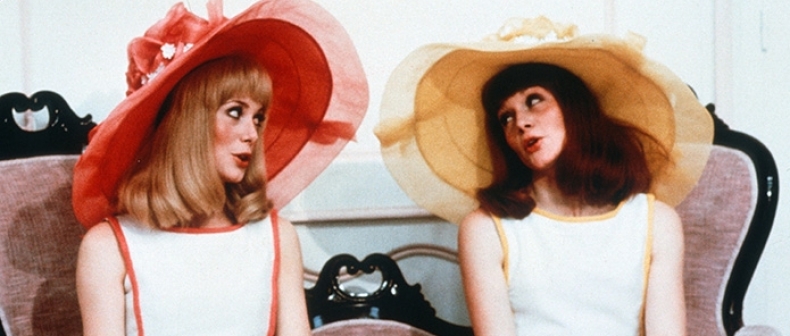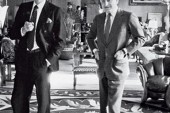
During high school I was friends with a bisexual girl who could be a tad melodramatic. One evening she phoned me in tears. Embarrassed, for awhile she wouldn’t tell me what was wrong. Finally she blubbered out, “Catherine Deneuve has had plastic surgery!” I thought she was trying to change the subject, but this revelation about the queen of French cinema was what upset her. Deneuve was around 60 years old at this point and retained the beauty that made her famous, but, in my friend’s mind, cosmetic surgery sullied her image. What can I say? Teenagers are idealistic.
We had all gone and seen her recently in 8 Women, a musical-slash-murder mystery that combined French pop songs, mid-century Technicolour, and just enough Sappho-erotica to keep my friend writhing in her seat. I learned later that Deneuve has had a lesbian following since 1983’s The Hunger, in which she played a vampire and had a sex scene with Susan Surandon.
Deneuve has broke sexual taboos her entire career (that now includes more than one hundred movies.) In ‘Belle de Jour’, arguably her definitive film, she played a bored housewife who seeks sexual awakening by becoming a sex worker at a brothel. Groundbreaking for 1967, but when I tried to watch it on TV I eventually gave up. I wondered how you could make a movie about sex so boring.
In her movies from her youth, you can’t deny Deneuve’s beauty–high cheekbones, dewy skin, and soulful, dramatic eyes. Her visage has been used for representations of Marianne, the personification of the French Republic. But she was a more far-reaching symbol of her country as the face of Chanel (causing perfume sales in North America to soar during in the 1970’s) and as a longtime muse and friend to Yves Saint Laurent. The pair had been close since he created her bourgeoisie-chic costumes for Belle de Jour.
I happened to be in France when Saint Laurent passed away. Photographs of Deneuve attending his funeral were on every newsstand. Visibly grief-stricken, the actress held a sheaf of wheat (a tribute to her friend’s success) as though she really was an allegory come to life.
I suspected Catherine Deneuve was considered a style icon more on account of her YSL-connection and what she wears in real life than for how she looked in any movie. To test this hypothesis I watched two films by director Jacques Demy, the subject of a TIFF Bell Lightbox retrospective beginning next week. Part of the French New Wave, Demy separated himself from black and white existentialist conversations by embracing bright colours, light hearted musical scores, and buckets of whimsy. He was Baz Luhrmann in a time before most people had heard of ‘camp.’
The Umbrellas of Cherbourg from 1964 was Deneuve’s first big hit. A tribute to American musicals (at that point just beginning their long cultural decline) the entire film is sung to a soundtrack of jazz and schmaltzy ballads. The conceit is jarring at first (especially given the first conversation involves mechanics and a broken car), but you soon get used to it. In fact, forcing the actors to sing their lines slows the dialogue right down. I’ve never been able to follow so many French lines without having to look at the subtitles. (Although, like most of the actors, Deneuve was dubbed which means you don’t hear her real voice once in the film.)
The other thing The Umbrellas is known for is the colour. Demy discarded realism and painted the walls of the coastal town Cherbourg bright blue, green, and pink, often matching the outfits of the actors standing in front of them. Inside, wallpaper is striped like candy canes, or decorated with pink flowers on light blue, a pattern replicated on one of Deneuve’s silk dresses. Most of her clothes are solid colours, though, and they take her through girlish adolescence into posh maturity. At the end of the film, draped in black fur and with high piled hair extensions, she suddenly turns into Mrs. Robinson.
Despite the weepy plot and surrealist art direction (or perhaps because of it), the film was a hit internationally. Three years later, Demy filmed an almost-sequel–‘The Young Girls of Rochefort’. Deneuve was paired with her sister Françoise Dorléac, who died tragically in a car accident not long afterwards. The sisters play music-teaching twins in matching Easter egg-coloured dresses and wide-brimmed hats.
The plot, like a Shakespearean comedy, involves loves both lost and fresh, and incorporates modern art, a band of travelling carnies, and Gene Kelly. A ‘Singin’ in the Rain’ fan since I was a child, I squealed with glee at the first sight of Kelly (in a form-hugging pink Polo shirt). But when he opened his mouth to sing, it wasn’t his distinctive, slightly-nasal voice that came out, but that of a French person. Could he have not learned the lyrics phonetically?
Near the film’s conclusion, Deneuve and her sister don red sequined gowns and opera gloves. It’s supposed to be like Marilyn Monroe and Jane Russell in ‘Gentlemen Prefer Blondes’. It reminded me of Miss Piggy.
Other than her prettiness, are there traces of the style icon Catherine Deneuve would become in this early movies? Not particularly. Demy’s art direction is so overpowering that Deneuve is almost literally lost among the scenery. But she wears the clothes well and makes them appear almost normal, a must if the viewer is to believe anything on screen. There would be plenty of time later for Deneuve to become a fashion plate and the arch-eyebrow face of France.
____
Max Mosher writes about style for Toronto Standard. You can follow him on Twitter at @max_mosher_.
For more, follow us on Twitter @TorontoStandard or subscribe to our newsletter.














